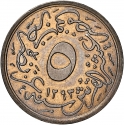You are about to finish your registration. Please check your mailbox (including spam folder). There should be a letter with a confirmation link. Check setting to make sure that your e-mail address is correct.
Send letter againDescription
Mehmed V. Reşâd (1844–1918) was the 35th and penultimate Ottoman Sultan (reign 1909–1918). He was the son of Sultan Abdülmecid I. He was succeeded by his half-brother Mehmed VI. His nine-year reign was marked by the cession of the Empire's North African territories and the Dodecanese Islands, including Rhodes, in the Italo-Turkish War, the traumatic loss of almost all of the Empire's European territories west of Constantinople in the First Balkan War, and the entry of the Empire into World War I, which would ultimately lead to the end of the Ottoman Empire.
He was largely a figurehead with no real political power, as a consequence of the Young Turk Revolution in 1908 (which restored the Ottoman Constitution and Parliament) and especially the 1913 Ottoman coup d'état, which brought the dictatorial triumvirate of the Three Pashas to power. Mehmed V died on 3 July 1918 at the age of 73, only four months before the end of World War I. Thus, he did not live to see the downfall of the Ottoman Empire.
The Khedivate of Egypt (1867–1914) was an autonomous tributary state of the Ottoman Empire, established and ruled by the Muhammad Ali Dynasty following the defeat and expulsion of Napoleon Bonaparte's forces which brought an end to the short-lived French occupation of Lower Egypt. The Khedivate of Egypt had also expanded to control present-day Sudan, South Sudan, Eritrea, Israel, Lebanon, Jordan, Syria, Greece, Cyprus, southern and central Turkey, and northwestern Saudi Arabia.
Obverse

|
Tughra in Mehmed V name, flowered border up both sides, starting from the base. Central design with a flower on the right. The year of the reign below. محمد بن عبد المجيد المظفر دائما |
|---|---|
Reverse

|
Central 5 numeral, surrounded by the legend "Struck in Egypt" in Arabic and the Sultans accession (first year of the rule) in Hejira (AH1293) below. Mint mark below. ٥ |
| Edge |
5/10 Qirsh
(Piastre)
Khedivate
KM# 304
Characteristics
| Material | Cupronickel |
| Weight | 4 g |
| Diameter | 21 mm |
| Thickness | 1.4 mm |
| Shape |
|
| Alignment | Medal |
| Mints |
Cairo Mint Heaton Mint, Birmingham (H)
|



